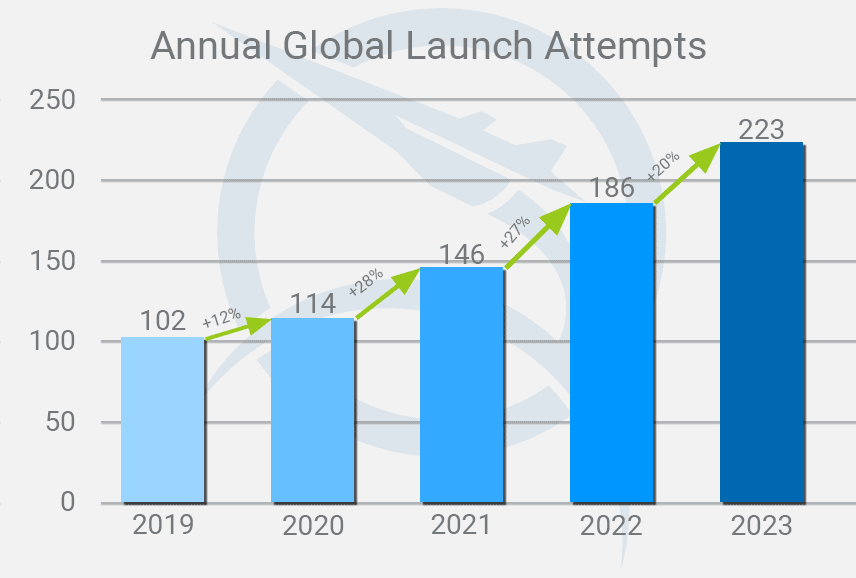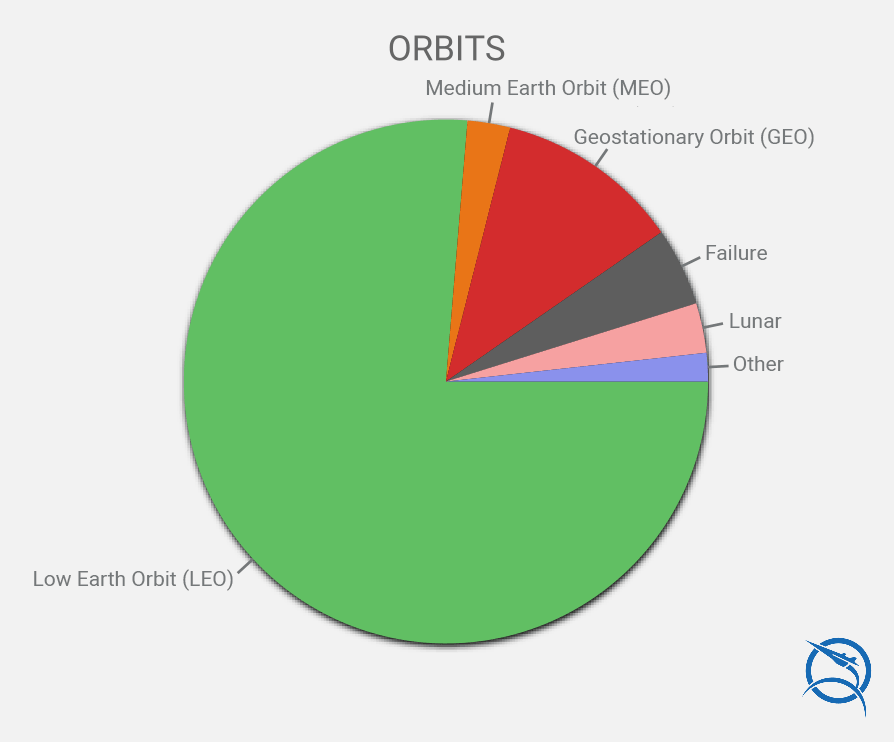Where did We Leave Off?
In the middle of 2023, we shared our Global Launch InfoVideo with commentary covering the 97 global orbital launches for the first half of the year. Now that 2023 is in the rear-view mirror, we’re back with an updated InfoVideo covering all the launches from January through December with fresh insights! So, without further ado, Happy New Year and let’s take a look at all the launches from 2023…
Can’t Stop, Won’t Stop
Global orbital launches set a new all-time high this year at 223, surpassing the 186 launches in 2022 by almost 20%. This continues the trend that’s been established over the last few years and the launch industry shows no signs of slowing down anytime soon. New launch vehicles are becoming operational while others are starting to effectively scale up their cadence. With that being said, getting to space is still very hard and not everything went smoothly in 2023. Time to dive into some of the key highlights from the past year!

As a reminder, these numbers don’t include suborbital launches so for example, Rocket Lab’s HASTE missions, Virgin Galactic’s SpaceShipTwo flights, and Blue Origin’s New Shepard flights aren’t included here.
Launches from Around the World
Breaking this out at the country level, most of the launches are being driven by the United States and China. The U.S. hosted 108 launches with 8 additional launches by U.S. companies carried out in other countries (Rocket Lab had 7 launches from New Zealand and Virgin Orbit conducted their final launch from Spaceport Cornwall out of the United Kingdom).

It’s about the Destination, not the Journey
Low Earth Orbit (LEO) remains the hottest destination with over 80% of successful launches deploying payloads there. Many companies and agencies are deploying constellations like SpaceX’s Starlink (>4,000 Starlink satellites now in orbit) and SDA’s Proliferated Warfighter Satellite Architecture. Japan had an interesting launch where they dropped off JAXA/NASA’s XRISM telescope and then continued on to send their SLIM lunar lander to the moon. It should also be noted that Firefly’s final launch of the year was a partial failure since it reached LEO but at a much lower altitude than desired which means that the Lockheed Martin payload will unfortunately deorbit within a month or two.

The next most popular orbit with about 12% of the launches is geostationary orbit (GEO) where the satellites are typically larger and can cover much more of the Earth. As a note, we are including launches that put payloads into geostationary transfer orbits (GTO) as GEO launches. We decided to focus on the final intended orbit rather than the initial drop-off. Medium Earth Orbit (MEO) got almost 3% of successful launches while launches destined for beyond Earth’s orbit (xGEO) were just over 3%.
Aim for the Moon…
Although most payloads were deployed in Earth’s orbits, there were a handful of launches with payloads destined for more far off locations. Let’s start with the Moon. Japan’s ispace was the first to attempt a moon landing this year in April after launching their Hakuto-R M1 mission in December 2022. They were unfortunately unsuccessful. They were followed by India’s Chandrayaan-3 lunar mission which safely landed on the Moon, making it the fourth country to successfully do so. Next, Russia’s Luna 25 lander experienced some issues, resulting in a crash landing (successful launch though). Finally, Japan’s SLIM lander is currently on its way to the moon and is expected to attempt a landing on January 19th, 2024.
Even though the moon is getting more visitors as of late, the rest of the solar system hasn’t been forgotten. Four more launches went to other locations besides the Earth and Moon. India sent their Aditya-L1 solar probe to Sun-Earth L1 (Lagrange point 1) to study the sun. ESA sent JUICY to Jupiter and then used SpaceX to send Euclid to Sun-Earth L2 to study dark matter and dark energy. Finally, NASA launched their Psyche spacecraft to study – you guessed it – an asteroid named Psyche.
SpaceX Continues to Dominate
Of the 108 U.S. launches, 98 were performed by SpaceX (~90%). Roughly two-thirds of SpaceX’s launches were primarily for Starlink satellite deployment though. The rest of the launches consisted of customer payloads (including 5 Transporter rideshare missions), ISS crew and cargo missions, and the first two launch attempts for the Starship/Super Heavy launch vehicle. Both of which ended in explosive fashion. Right now, no other launch provider is coming close to SpaceX’s numbers. China’s CASC is the next most frequent flyer at 47 launches in 2023, followed by Roscosmos at 12 and Rocket Lab at 9. SpaceX’s Falcon 9 launched, on average, every 3.8 days in 2023. This cadence will likely improve in 2024 but it will be interesting to see if launch pad congestion becomes more prominent (maybe not this year but soon) as more launch providers aim to grow their market presence. Food for thought…
Space! But Make it Fast>>>>
One of the most unique launches of the year was perhaps the Victus Nox mission carried out by Firefly and Millenium Space Systems to demonstrate tactically responsive space. What does this mean? Well usually launch providers need the payloads they are flying delivered weeks, if not months, in advance for testing and integration with the launch vehicle. Furthermore, they need this time to make sure the vehicle is healthy and ready to launch without issue. Victus Nox executed payload transportation, fueling, testing, and integration with Firefly’s Alpha launch vehicle within 58 hours and then performed final launch vehicle tests, check outs, and preparations to enable a launch 27 hours after being given the go-ahead. Finally, the payload was operational in orbit 37 hours after launch. The previous record for all this was 21 days for the TacRL-2 mission, Victus Nox’s predecessor. All things considered, this was a very impressive demonstration mission and something the DoD hopes to have in their operational back pocket by 2026. Victus Haze will be the next mission for tactically responsive space and will aim to beat the records set by Victus Nox.
Can’t Make an Omelet Without Breaking a few Eggs…
Unfortunately, not every launch was able to reach their desired orbit. There were 11 failed launch attempts this past year. Three were first launch attempts by ABL’s “RS-1”, Mitsubishi Heavy Industries’ “H3”, and Relativity’s “Terran 1.” Two were SpaceX’s first and second flight attempts for their “Starship/Super Heavy” launch vehicle. North Korea failed twice before finally putting a spy satellite in orbit. Iran had a failed launch of their Qaem-100 vehicle early this year. Virgin Orbit’s failed launch from the U.K. was probably the most detrimental and unfortunately led the way to their bankruptcy and dissolution earlier this year.
The two most shocking failures though came from companies with impressive track records. China’s Galactic Energy experienced their first failure after maintaining perfection through 9 successful launches. Then Rocket Lab experienced a launch failure for the first time since May of 2021. They have been the most reliable U.S. launch company behind SpaceX, so their failure was a little surprising but not entirely. As we pointed out earlier, it’s still very hard to get to space. To their credit, the conditions that had to be in place to cause the failure were incredibly unique and would be unlikely to occur again. Either way, Rocket Lab made improvements and successfully returned to flight in the final month of the year.
Thanks for Tuning In
With 2023 behind us, we’re excited to see all that’s to come in 2024. The year is already off to a hot start with ULA’s Vulcan Centaur nailing its first certification launch with Astrobotic’s Peregrine lander as the main payload. Unfortunately, Peregrine seems to have had a propulsion issue that will end its mission prematurely, but we still have Intuitive Machine’s IM-1 lunar mission set to launch next month to look forward to. With the first launch of Vulcan successful, ULA should be interesting to watch in 2024 as there are three potential buyers for it (Blue Origin, Cerberus, and Textron). Beyond that, keep an eye out for companies returning to the pad with improved launch vehicles and more established players looking to start chipping away at SpaceX’s market share. Space is Go in 2024!

